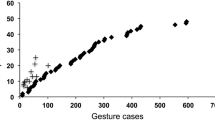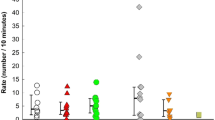Abstract
Accuracy scores for both the interpretation and transmission of twelve frequently employed gestures were obtained for eight groups of children differing in social class, education, and sex. Results indicated that middle class children were more accurate in transmitting and interpreting gestures than lower class children. Children with one year of school were more accurate in transmission and intepretation of gestures than children with no prior school. Boys were more accurate than girls in the interpretation of gestures.
Similar content being viewed by others
References
BAYLEY, N. 1955. The growth of intelligence. Amer. Psychologist., 10, 805–818.
BOAS, F., EFRON, D., & FOLEY, J. P. 1936. A comparative investigation of gestural behavior patterns in racial groups living different as well as similar environmental conditions. Psychol. Bull., 33, 760.
BREWER, W. A. 1951. Patterns of gestures among the Levantine Arabs. Amer. Anthropologist, 53, 232–237.
DEUTSCH, M. & BERT, B. 1964. Social influences in Negro-white intelligence differences. J. soc. Issues, 20, 24–35.
JAHODA, G. 1964. Social class differentials in vocabulary expansion. Brit. J. educ. Psychol, 34, 321–323.
LABARRE, W. 1947. The cultural basis of emotions and gestures. J. Pers., 16, 49–69.
NEFF, L. 1938. Social economic status and intelligence: a critical survey. Psychol. Bull., 35, 727–757.
PHILLIPS, B. V. 1962. Sex, social class, and anxiety as sources of variation in school achievement. J. Educ. Psychol., 53(6), 316–322.
RALPH, J. B. 1965. Language development in socially disadvantaged children. Rev. educ. Res., 5, 389–400.
RUESCH J., & KEES, W. 1956. Nonverbal Communication. Berkeley: University of California Press.
SCHWEBEL, A. K. 1966. Effects of impulsivity on performance of verbal tasks in middle and lower class children. Amer. J. Orthopsychiat., 36, (1), 13–21.
WELLMAN, B. L. 1938. The intelligence of preschool children as measured by the Merrill-Palmer Scale of Performance Tests. University of Iowa Studies in Children Welfare. 15(3).
WHITE, L. A. 1949. The Science of Culture. New York: Grove Press.
Author information
Authors and Affiliations
Rights and permissions
About this article
Cite this article
Michael, G., Willis, F.N. The Development of Gestures as a Function of Social Class, Education, and Sex. Psychol Rec 18, 515–519 (1968). https://doi.org/10.1007/BF03393801
Published:
Issue Date:
DOI: https://doi.org/10.1007/BF03393801




